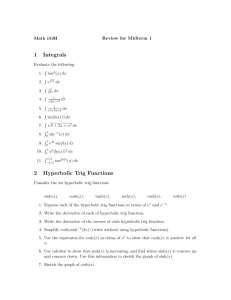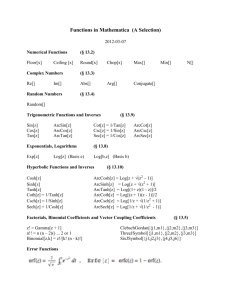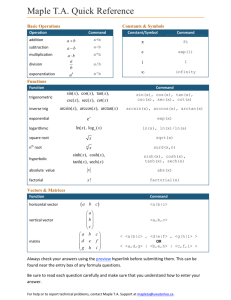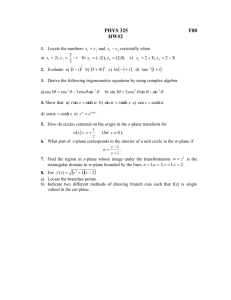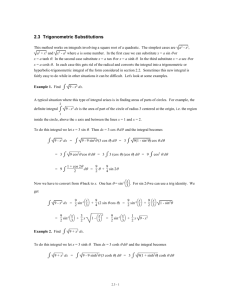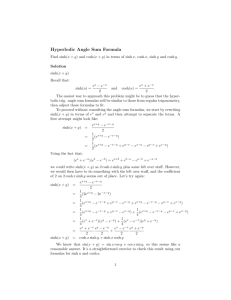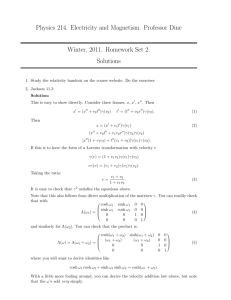Hyperbolic Functions
advertisement
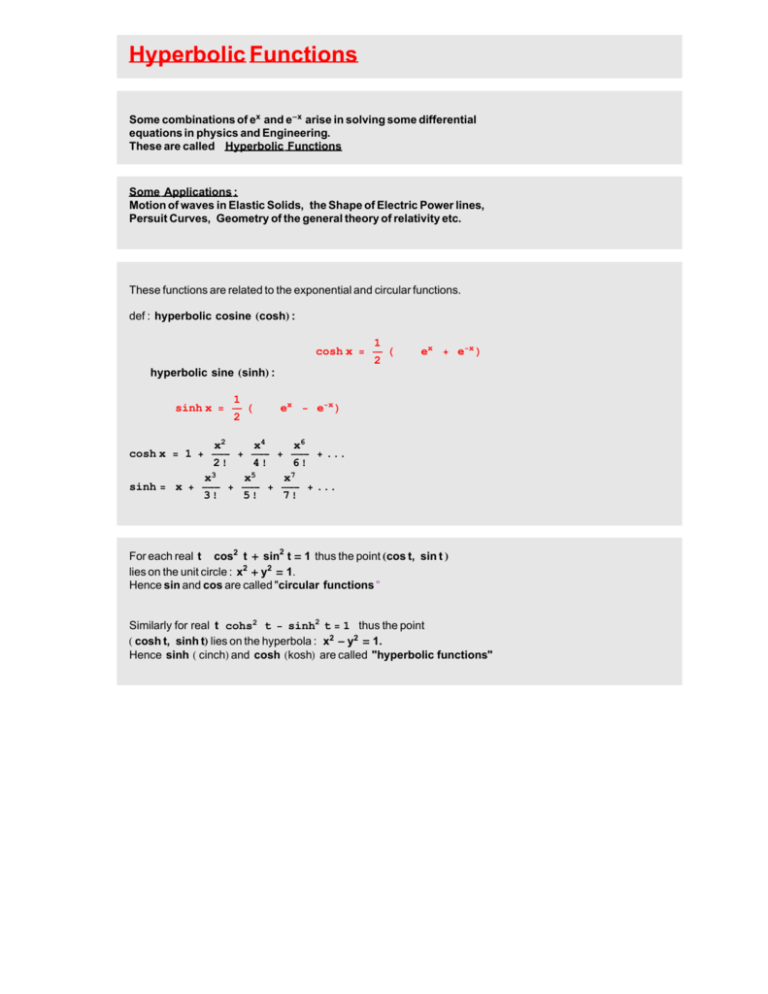
Hyperbolic Functions
Some combinations of ex and e-x arise in solving some differential
equations in physics and Engineering.
These are called Hyperbolic Functions
Some Applications :
Motion of waves in Elastic Solids, the Shape of Electric Power lines,
Persuit Curves, Geometry of the general theory of relativity etc.
These functions are related to the exponential and circular functions.
def : hyperbolic cosine HcoshL :
hyperbolic sine HsinhL :
1
sinh x = H
2
1
cosh x = H
2
ex + e-x L
ex - e-x L
x2
x4
x6
cosh x = 1 + + + + ...
2!
4!
6!
x3
x5
x7
sinh = x + + + + ...
3!
5!
7!
For each real t cos2 t + sin2 t = 1 thus the point Hcos t, sin t L
lies on the unit circle : x2 + y2 = 1.
Hence sin and cos are called "circular functions "
Similarly for real t cohs2 t - sinh2 t = 1 thus the point
H cosh t, sinh tL lies on the hyperbola : x2 - y2 = 1.
Hence sinh H cinchL and cosh HkoshL are called "hyperbolic functions"
Other hyperbolic functions :
Analogous to circular functionsM :
sinh x
H
ex + e-x L
tanh x = =
cosh x
H
ex - e-x L
1
sech x =
cosh x
1
cosech x =
sinh x
1
coth x =
tanh x
Graphs of cosh x and sinh x
1
cosh x = H
2
ex + e-x L
,
1
sinh x = H
2
1
2
sech x = =
cosh x
Hex + e-x L
1
cosh 0 = H
2
1
e0 + e-0 L = H1 + 1L = 1
2
1
2
cosech x = =
sinh x
H
ex - e-x L
1
sinh 0 = H
2
1
e0 - e-0 L = H1 - 1L = 0
2
1
ex + e-x
coth x = =
tanh x
ex - e-x
ex - e-x L
Inverse Hyperbolic Functions :
HAnalogous to sin-1 x and cos-1 xL
Logarithmic Forms :
y = sinh-1 x means x = sinh y
or
multiply by ey
ey - e-y L
or 2 x =
ey - e-y
and rearrange to e2 y - 2 x ey - 1 = 0
ey = u, so
Set
1
x = H
2
e2 y = u2 , to get
u2 - 2 xu - 1 = 0 Hquadratic in uL
!!!!!!!!!!!!!!!!!
2 x + - 4 x2 + 4
u = ey =
2
!!!!!!!!!!!!!
= x + - x2 + 1
Roots :
so
ey = x +
- sign is rejected since ey > 0
!!!!!!!!
!!!!!
x2 + 1
Taking ln and noting ln e = 1
y = sinh-1 x = ln Ax +
!!!!!!!!
!!!!!
x2 + 1 E
for all x.
cosh-1 x = ln Ax +
!!!!!!!!
!!!!!
x2 - 1 E
x³1
Similarly
Example :
y = tanh-1 x
ey - e-y
e2 y - 1
x = tanh y = = ,
ey + e-y
e2 y + 1
hence
so
x He2 y + 1L = e2 y - 1,
1+x
e2 y =
1-x
Since e2 y > 0 so - 1 < x < 1
or È x È < 1. Taking ln we get
1+x
2 y ln e = ln
1-x
or
1
1+x
y = tanh-1 x = ln ,
2
1-x
ÈxÈ <1
Hyperbolic Identities :
1
cosh x = Hex + e-x L
2
From
and
we get
and
1
sinh x = Hex - e-x L
2
cosh x + sinh x = ex
cosh x - sinh x = e-x
Multiply last two equations to get
cosh 2 x - sinh2 x = 1
H cos 2 x + sin2 x = 1L
From this we can get others
sech 2 x = 1 - tanh2 x
H sec 2 x = 1 + tan2 xL
cosech 2 x = coth2 x - 1
Hcosec 2 x = 1 + cot2 xL
Now from definition;
1
cosh Hx + yL = Hex+y + e-Hx+yL L
2
1
= @ex ey + e-x e-y D
2
1
= @
2
or
Hcosh x + sinh xL Hcosh y + sinh yL
+ Hcosh x - sinh xL Hcosh y - sinh yL
cosh Hx + yL = cosh x cosh y + sinh x sinh y
Hcos Hx + yL = cos x cos y - sin x sin yL
Setting y = x gives
cosh 2 x = cosh2 x + sinh2 x
H cos 2 x = cos2 x - sin2 xL
D
From this it is easy to show :
cosh 2 x = 2 cosh2 x - 1 = 1 + 2 sinh2 x
Hcos 2 x = 2 cos2 x - 1 = 1 - 2 sin2 xL
sinh Hx + yL = sinh x cosh y + cosh x sinh y
Hsin Hx + yL = sin x cos y + cos x
sin yL
Similarly
sinh 2 x = 2 sinh x cosh x
Hsin 2 x = 2 sin x cos xL
2 tanh x
tanh 2 x =
1 + tanh2 x
And
2 tan x
tan 2 x =
1 - tan2 x
etc
Recall Euler’ s Relation
ejΘ = cos Θ + jsin Θ
e-jΘ = cos Θ - jsin Θ
By adding and subtracting
1
cos Θ = H ejΘ + e-jΘ L
2
1
sin Θ = H ejΘ - e-jΘ L
2j
Now
1
cosh x = H ex + e-x L
2
for
x = jΘ one gets
1
cosh jΘ = H ejΘ + e-jΘ L = cos Θ
2
or
Similarly
gives
Hence
cosh jΘ = cos Θ ... ... .. HiL
1
sinh x = H ex - e-x L
2
1
sinh jΘ = H ejΘ - e-jΘ L = j sin Θ
2
sinh jΘ = j sin Θ ... ... .. HiiL
Put Θ = jx in HiL to get
cos jx = cosh j2 x
= cosh H-xL
= cosh x
or
cos jx = cosh x ... ... ... ....HiiiL
Put Θ = jx in HiiL to get
j sin jx = sinh j2 x
= sinh H-xL
= -sinh x
Hence
or
j sin jx = j2 sinh x
sin jx = j sinh x ... ... ... ... .. HivL
Important Results :
sin jx = j sinh x
sinh jx = j sin x
cos jx = cosh x
cosh jx = cos x
tan jx = j tanh x
tanh jx = j tan x
Example :
5
solve sin z = -
4
Let z = x + jy,
then
NB. z cannot be real
sin Hx + jyL = sin x cos jy + cos x sin jy
= sin x cosh y + j cos x sinh y
Hence
sin z = sin Hx + jyL
= sin x cosh y + j cos x sinh y
5
= -
4
Thus
5
sin x cosh y = - ... ... ....HiL
4
cos x sinh y = 0. ... ... ... ....HiiL
From HiiL either
sinh y = 0
ie y = 0,
or
Π
3Π
x = +- , +- , ...
2
2
cos x = 0,
HaL If y = 0 then cosh y = 1 and from HiL
Do you believe that ?
HbL If cos x = 0, then sin x = +1 or - 1
HiL sin x = +1, then from HiL
HiiL sin x = -1,
ie.
Also now from HiL
5
sin x = -
4
Hwhy?L
5
cosh y = -
4
5Π
Π
3Π
7Π
x =. .. - , - , , , ...
2
2
2
2
5
cosh y =
4
or
or
1
5
Hey + e-y L = ,
2
4
2 ey + 2 e-y - 5 = 0
2 e2 y - 5 ey + 2 = 0
or
A quadratic in ey with factors
H2 ey - 1L Hey - 2L = 0
1
Roots : ey = and ey = 2
2
Taking ln :
1y
j
y = ln i
z or
j z
k2{
and
y = ln 2.
Hence z = x + yj
HImpossibleL
y = -ln 2
Π
3Π
7Π
x =. .., - , , , ...
2
2
2
y = +-ln 2
